Winter Sunscald and Frost Cracking: Tree Bark Damaged from Winter Bite
Sunscald and frost cracking of trees can occur in any winter, but the effect of dramatic temperature changes can also lead to the occurrence of these problems. These conditions are rarely fatal to trees on their own but could lead to further problems, due to the additional damage caused by invading decay organisms.
Winter Sunscald
Sunscald can occur at any time of the year, but damage initiated in the winter is often the most severe. The damage may not be seen immediately after it has occurred. Sunken, discoloured bark, with subsequent cracking and peeling of the bark (See Figures 1 and 2) may not become apparent until spring or summer, when new growth occurs.
In Manitoba, for example, January saw a range of fluctuating temperatures, ranging from just above 0°C to below -30°C. Not all of these days had bright sunshine, but even at temperatures well below freezing, the temperature of the bark can increase by several degrees, triggering growth. Subsequent drops in temperature (notably at night), can result in rapid freezing and death of the developing inner bark tissues.
Sunscald damage alone would rarely be sufficient to kill a tree, though excessive damage to a very young tree (such as one or two year old nursery stock) could do enough damage that replacement may be worth considering. The secondary effects of entry by insects and decay organisms could cause further damage to the tree.
Ash (Fraxinus), Oak (Quercus), Maple (Acer), Birch (Betula), Willow (Salix), Basswood/Linden (Tilia), and Honeylocust (Gleditsia) and most fruit trees are susceptible to sunscalding. However, any newly planted tree, could be injured by sunscald if grown under poor conditions.

Figure 1. Bark peeling from Green Ash tree (Fraxinus pennsylvanica) injured by effect of sunscald.
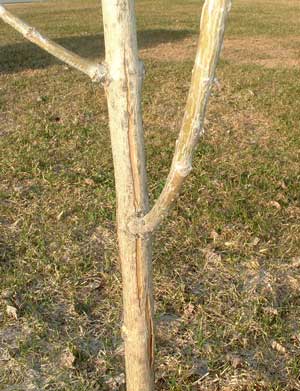
Figure 2. Bark cracking on young Manchurian Ash (Fraxinus mandshurica).
Sunscald Management
Prevention
To prevent sunscald, wrap the trunks of young trees with white tree wrap (this product may be purchased at various garden centres. Don’t confuse it with burlap). This material helps to insulate the trunk from the excessive warming effect of direct sunlight. Wrap the trunk in late fall, and remove the wrap in early spring. Painting tree trunks white is another option; a practice often done in commercial fruit tree plantings, used to reflect the sun’s rays.
Curative
After damage has occurred, the tree will normally heal itself through growth of the inner bark, on the edges of the split. A sharp, sterilized knife (dipped in 10% bleach solution or 70% alcohol for several minutes) could be used to remove loose bark from the area of the split, which will speed up the healing process (See Figure 3). The resulting bare patch on the trunk should be left untreated. Tree wound paints and tars do not help in wound healing, and should NOT be applied. Encourage good tree vigour with spring fertilizer applications if the tree is exhibiting nutrient deficiencies and provide adequate water in hot dry weather.
Frost Cracks
Frost cracks (See Figure 4) are often the result of some sort of predisposing factor, which occurred to the trunk years earlier. In late winter and early spring, water in the inner bark and in the wood expands and contracts under fluctuating temperatures. Defective wood does not contract as well as healthy wood. Rapid expansion and contraction of water within the wood and bark, particularly under falling night temperatures, can result in a crack. Frost cracks may be up to several feet long and are often found on the southwest side of the tree. These cracks may heal in the summer only to reopen again in winter. Successive cracking and healing over years can result in the formation of “frost ribs” (See Figures 5a and 5b) on the sides of affected trees. Frost cracks can act as sites of entry for wood decay organisms.
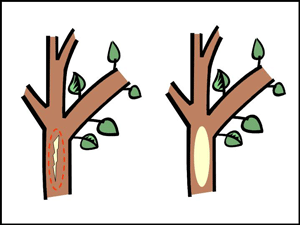
Figure 3. Bark tracing to remove cracked bark on trunk On left: Cracked/split bark, with portion to be cut out outlined in red On right: Trunk with bark portion removed from tree
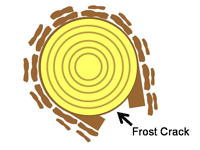
Figure 4a. Cross section of tree, showing frost crack, where bark is pulled away, exposing underlying wood (after Franklin and Clatterbuck, 2004)
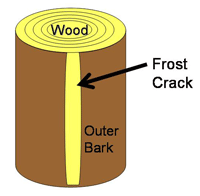
Figure 4b. From side view, the frost crack appears as an extended vertical crack on the side of the tree trunk
Management of Frost Cracks
Avoiding fertilization late in the growing season can reduce the incidence of splits. Instead, wait to apply fertilizer until after the leaves have dropped in the fall.
Avoid damaging the bark of trees when they are young. Bumping into trees with lawn mowers, car bumpers, golf clubs, shovels, etc. should be avoided.
Place mulch around young trees to eliminate the need for mowing close to the trunk to prevent damage from lawnmower and grass trimmers.

Figure 5a. Frost Rib on Green Ash (Fraxinus pennsylvanica); damage occurred years before this picture was taken
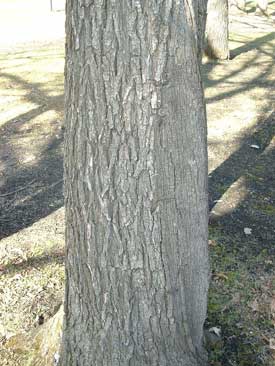
Figure 5b. Frost Rib (bulge) on Bur Oak (Quercus macrocarpa)
References
- Franklin, J. and Clatterbuck, W.K. 2004. Bark Splitting on Trees. University of Tennessee Extension Publication Number SP630.
- Sinclair, W.A., Lyon, H.A., and Johnson, W.T. 2005. Diseases of Trees and Shrubs. 2nd ed. Ithaca: Cornell University Press.

